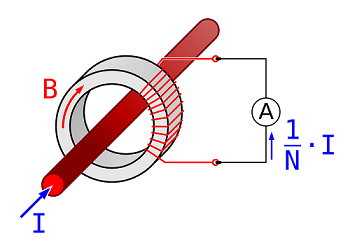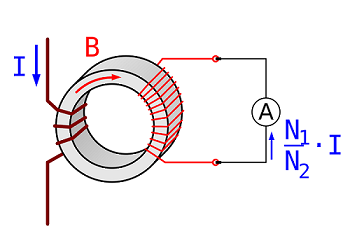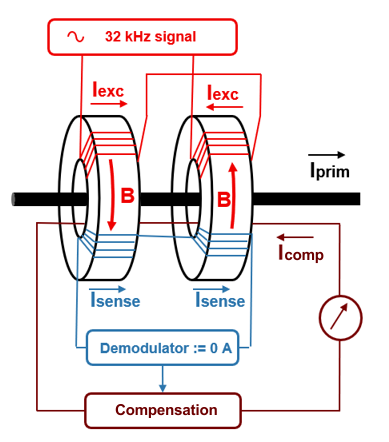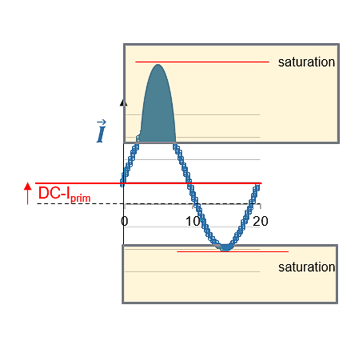Basics current transformers
Basic information on the technology area of current transformers is given in the following. The information is of general nature; so it is imperative to check the extent to which these notes apply to your specific application.
Function and design
A current transformer is a transforming device that transforms an input current into a processable current signal at the output. A current transformer is mainly used to transform currents of large magnitudes to directly measurable, smaller values in the milliampere or small ampere range. With a classic current transformer, the input current is proportional to the output current. Due to the physical principle and the mechanical construction, the current signal is transmitted galvanically isolated to the evaluation electronics.
A current transformer basically consists of a small number of windings on the primary side and a larger number of windings on the secondary side. The current to be converted flows through the primary side. The windings are usually wound on an alternating magnetic ferrite ring core.
A typical transformer type is the ring core or ring-type current transformer. The current rail or current-carrying cable is often used as the primary winding, which is guided through the toroidal core of the transformer. Thus, the rail or line forms the primary winding with one turn. The secondary winding is located on the ring core. The transformation is determined by the ratio of the number of primary and secondary windings. The classic structure of a ring-type current transformer is shown in the following figure.
 Fig.2: Principle ring-type current transformer
Fig.2: Principle ring-type current transformerAnother classic type is the coiled current transformer. In this type of transformer, the primary winding is a current-carrying wire which is wound around the ring core on the primary side. In this case, the primary winding number is > 1, but smaller than the secondary winding number. The principle is shown in the following figure
 Fig.3: Principle coil current transformer
Fig.3: Principle coil current transformer
| |
Dangerous voltages with secondary side not connected The secondary winding must be connected to a current measuring device or short-circuited, otherwise high core losses or dangerous voltages may occur on the secondary side. Before replacing the measuring electronics in the secondary circuit, the current transformer must therefore be short-circuited at its secondary terminals. |
 | Grounding of secondary terminals According to DIN VDE 0141 (01/2000) paragraph 5.3.4, current and voltage transformers for nominal voltages from Um = 3.6 kV must be grounded on the secondary side. For low voltages (Um ≤ 1.2 kV), grounding is not required if the transformer housings do not have any metal surfaces with large contact areas. |
Characteristic values and calculation
In principle, the construction, and thus also the calculation, correspond to a normal transformer. The basic relationship between input and output current is determined by the ratio of the number of turns N of the primary and secondary sides. An important characteristic value in the design of a current transformer is therefore the transformer ratio.
IOut = N1/N2 * IIn
Technical terms of current transformers
Term | Explanation |
|---|---|
Primary rated current Ipr (alternative symbol IN) | Value of the rated current on the primary side |
Secondary rated current Isr | Value of the rated current on the secondary side. |
Rated power Sr | Value of apparent power (in [VA]) that the transformer can deliver to the secondary circuit at secondary rated current and rated load |
Rated frequency fR | Value of the rated frequency. |
Accuracy class | Indication that the measurement deviations are within specified limits under prescribed conditions of use. |
Rated insulation level Um | Highest voltage; RMS value of the highest conductor-to-conductor voltage for which a measuring transformer is rated with respect to its insulation The value of the rated insulation level is given in three values:
|
Overcurrent limiting factor (FS) | Ratio of rated limiting current to primary rated current. |
Rated continuous thermal current Icth | Value of the continuous current in the primary winding at which the overtemperature does not exceed the value specified in the standard, with the secondary winding loaded with the rated load. |
Rated short-time thermal current Ith | Value of short-time current for a limited time in the primary winding at which the overtemperature does not exceed the value specified in the standard, with the secondary winding loaded with the rated load. |
Rated peak current Idyn | Maximum value of the primary current whose electromagnetic force effect does not cause electrical and mechanical damage to the current transformer with short-circuited secondary winding. |
"Open voltage" of current transformers | Current transformers which are not directly connected to a load must be short-circuited on the secondary side for safety reasons! A current transformer operated open on the secondary side induces very high peak voltage values at its secondary terminals. The magnitudes of these voltages can reach values of up to several kilovolts, depending on the dimensioning of the current transformer, and thus represent a danger to persons and the functional safety of the transformer. For safety reasons, open operation should generally be avoided in order to prevent magnetization of the core iron during secondary open operation. |
Grounding of secondary terminals | According to DIN VDE 0141 (01/2000) paragraph 5.3.4, current and voltage transformers for nominal voltages from Um = 3.6 kV must be grounded on the secondary side. For low voltages (Um ≤ 1.2 kV), grounding is not required if the transformer housings do not have any metal surfaces with large contact areas. |
Principle of the fluxgate current measurement technology
While all SCT transformers except the SCT5xxx are based on the transformer principle described above, the technology of the all-current sensitive differential current transformers is fundamentally different.
 Fig.4: Principle fluxgate current measurement technology
Fig.4: Principle fluxgate current measurement technologyThe measuring principle of the SCT5xxx is based on a differential current measurement of two oppositely excited cores in the transducer. For this purpose, both cores are brought into saturation with an excitation winding (red) with an internally generated 32 kHz signal, whereby the first core is driven in the positive and the second in the negative range of the y-axis. See fig.)
 Fig.5: Characteristics fluxgate current measurement technology
Fig.5: Characteristics fluxgate current measurement technologyThe detection winding now measures the induced current of the excitation winding (blue). If the measuring current Iprim is 0, then 0 A is also measured, since no compensating current is generated for compensation.
If the measuring current Iprim is not equal to 0, a compensating current is generated through both cores, which again compensates for the disproportion of the magnetic flux density B in core 1 and core 2. Due to the compensation, Isense is 0 again.
The measured compensating current provides information about the current to be measured Iprim.
Together with a fixed excitation frequency, this leads to improved accuracy and stability.
General description of the fluxgate current measurement technology
The SCT series SCT5xxx is used for monitoring differential currents in electrical power supply systems that do not require fast system shutdown. The SCT5xxx type B/B+ can measure DC and AC residual currents at frequencies up to 100 kHz.
This makes this differential current transformer compatible with a wide range of industrial applications, loads and power sources. With its user-selectable settings, this series provides a flexible platform for differential current measurement suitable for any possible application, both at the time of industrial plant design and when expanding with new modern loads operating at DC voltages or high switching frequencies that increase the amount of leakage current in the system.
The SCT5xxx have an analog 4 - 20 mA output, which represents the real-time RMS value (TRMS) of the measured residual current for connection to a PLC, for example. In addition, a potential-free relay output (NO / NC) with a freely selectable residual current limit can be used for warning or even system shutdown if the TRMS residual current measured value has exceeded the preset value. The status of the relay output is replicated on an LED for visual indication on the device itself. A built-in test button and an external test button input are provided for periodic testing of the SCT5xxx according to the applicable product standards. Only a single 24 Vdc power supply should be provided for the SCT5xxx.
